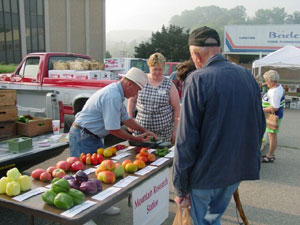Specialty Crops Survey for Western North Carolina-2002 Report
go.ncsu.edu/readext?438998
en Español / em Português
El inglés es el idioma de control de esta página. En la medida en que haya algún conflicto entre la traducción al inglés y la traducción, el inglés prevalece.
Al hacer clic en el enlace de traducción se activa un servicio de traducción gratuito para convertir la página al español. Al igual que con cualquier traducción por Internet, la conversión no es sensible al contexto y puede que no traduzca el texto en su significado original. NC State Extension no garantiza la exactitud del texto traducido. Por favor, tenga en cuenta que algunas aplicaciones y/o servicios pueden no funcionar como se espera cuando se traducen.
Português
Inglês é o idioma de controle desta página. Na medida que haja algum conflito entre o texto original em Inglês e a tradução, o Inglês prevalece.
Ao clicar no link de tradução, um serviço gratuito de tradução será ativado para converter a página para o Português. Como em qualquer tradução pela internet, a conversão não é sensivel ao contexto e pode não ocorrer a tradução para o significado orginal. O serviço de Extensão da Carolina do Norte (NC State Extension) não garante a exatidão do texto traduzido. Por favor, observe que algumas funções ou serviços podem não funcionar como esperado após a tradução.
English
English is the controlling language of this page. To the extent there is any conflict between the English text and the translation, English controls.
Clicking on the translation link activates a free translation service to convert the page to Spanish. As with any Internet translation, the conversion is not context-sensitive and may not translate the text to its original meaning. NC State Extension does not guarantee the accuracy of the translated text. Please note that some applications and/or services may not function as expected when translated.
Collapse ▲This is a 2002 report from a NC Specialty Crops Program Project. It is posted for historical reference purposes.
What is most important to you when you shop for produce?
- 81% Locally Grown
- 37% Quality
- 8.6% Price
Which of the items displayed here are you most likely to buy?
- 71% Heirloom Tomatoes
- 23.6% Jalapeno Peppers
- 5.3% Thai Dragon Pepper
- 22% Ivory Bell Pepper
- 34% Yellow Bell Pepper
- 6%Chocolate Pepper
- 16% Hybrid Tomatoes
- 7% Long Cayenne Pepper
- 15% California Wonder Pepper
- 29% Lilac Pepper
- 12% Valencia Bell Pepper
Have you bought specialty fruits or vegetables in the past?
- 72.6% Yes
- 27% No
Please share your age range
- 1.6% 21-30 (years old)
- 2.6% 31-40
- 17.3% 41-50
- 27.3% 51-60
- 28.6% 61-70
- 22.6% 71-80
Size of household?
- 12.6% One person
- 67.0% Two people
- 11.0% Three people
- 9.0% Four or more
What fruit or vegetables do you want to buy from farmers but can’t find?
| Blue Lake Beans | Snap Sweet Peas |
| Zucchini Squash | Fresh Asparagus |
| Ramps | Fresh Broccoli |
| Sweet Potatoes | Kiwi |
| Organic Grown Greens | Raspberries |
| Yellow Cherries | Kale |
| Cantaloupe | Turnips |
| Green Mountain Potatoes | Swiss Chard |
| Horse Radish | N.C. Peaches |
| June Apples | Egg Plant |
| Kohlrabi | White Corn Meal |
| Rhubarb | Cow Peas |
Source of data
100 Surveys were collected from: WNC Farmers Market, Waynesville Tail Gate Market, and Ingles.
Reviewed 7/4/2022. Jeanine Davis, NC Alternative Crops & Organics Program, Department of Horticultural Science, NC State University



